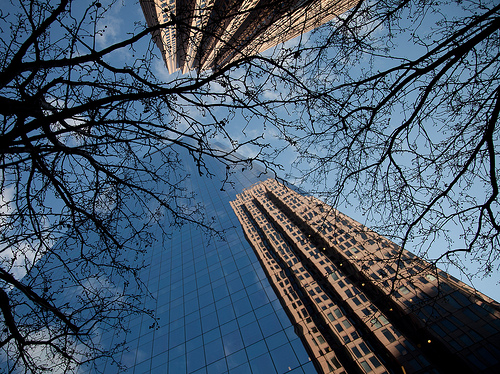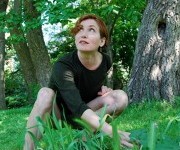Leda Meredith shows that foraging is another healthy function of city parks.Photo: Kethevane GorjestaniCross-posted from OnEarth.
Fans of dandelion greens, mushrooms, and other wild edibles in New York City, take heed. After years of unofficially tolerating foraging in parks, city park rangers are now cracking down on the increasingly popular practice, chasing off foragers and issuing summonses, as detailed in a recent front page story in The New York Times. Why? Some sources report wild ginger, ramps, and even entire cherry trees being uprooted and swiped from city parks. The Central Park Conservancy says it is concerned that its native species restoration efforts could be at risk, and one official there told the Times that chipmunks could go hungry as a result of salad-seeking humans out-competing them.
But is foraging truly as harmful to the parks’ ecosystems as all that? I checked in with expert forager and cookbook author Leda Meredith, who leads frequent tours of edible goodies in Brooklyn’s Prospect Park and other city locales, for some perspective.
Q. You’ve been foraging for a decade in New York City parks. Have you seen evidence recently that foraging dilettantes might be upsetting the balance?
A. Not really. It’s true that foraging is getting more popular, and I do see signs that other people are collecting more often. But most of it seems to be done by knowledgeable foragers. I don’t see any plants getting wiped out. Foragers tend to be a really environmentally aware group.
Q. I guess you have to have a certain amount of botanical knowledge just to avoid poisoning yourself with a toxic plant.
A. Exactly. It also helps that the two most commonly foraged plants are dandelions and garlic mustard, which happen to be very invasive and fast growing. I’d say those two make up the bulk of what’s taken out of Prospect Park and probably most city parks. So when it’s done right, it’s actually beneficial and environmentally friendly. The city seems to be confusing responsible foraging with outright theft. There’s a huge difference between picking mulberries and stealing an entire mulberry bush, for instance.
Q. But isn’t it a blurry line? Wouldn’t it be hard to stop only the foragers who, say, harvest fruit or leaves in a way that damages the plant?
A. In any population there will be some irresponsible people, but that’s not an argument for totally banning an activity. When cars became more popular, they didn’t outlaw driving just because there were more irresponsible drivers on the road. Instead you need more education and reasonable regulations.
Q. So here’s a thought: Should parks start requiring a foraging license?
A. I think it’s a really interesting idea. Why not require people to take a test to show they know how to identify plants and harvest sustainably? It would help protect the parks, and it would also prevent people from mistakenly harvesting something toxic, which is another concern the city has brought up in the past. It wouldn’t be much different than a hunting permit.
Q. Is it easy to tell which edible plants should be considered fair game?
A. Usually. Wild ginger is a beautiful native ground cover, and it’s clear that the parks department went to a lot of trouble to intentionally plant it, so it’s definitely a bad idea to harvest it, even though it is tasty. But I guarantee no one wants the dandelions to propagate. Yet there they are. Why not encourage people to take some greens? There are also lots of trees and bushes that can easily be picked from sustainably, like the apple trees in Central Park. In the fall, apples are falling and rotting on the ground — and they’re not some kind of ornamental variety. They’re delicious. There are fruit-bearing trees like this in parks all over the city. The city could even plant more, and people could be allowed, or even encouraged, to take some fruit home.
Q. But is that what a park is really supposed to be for? We have farms and gardens and orchards to provide us with food. Should we expect the same from parks?
A. The primary function of a park should always be to provide a natural landscape where we can all get away from the asphalt. That should always be No. 1. But if they can also provide direct nourishment at the same time, why shouldn’t they? After all, historically, the idea of a park grew out of the village commons. So if you’re planting trees anyway, so why not choose apple trees or walnut trees? Modern parks already serve lots of secondary purposes really well. We have Shakespeare plays to provide arts, ballparks and skating rinks to provide a place to exercise, playgrounds to provide a safe place to jump and climb. This kind of complexity is what makes a big urban park a really special place, and it in no way hurts the primary mission of the park.
Q. You’ve got a tour planned in Prospect Park on Saturday. Are you worried about being the target of a sting operation?
A. Not at all. In fact, I issued an open invitation to the parks department to come along unannounced via my blog, Facebook, and Twitter. If they do show up, they’ll see that what I’m doing is quite responsible and could actually help them. I teach people to care deeply about the parks — as I do — as anyone does when they get to know a place on the level you need to in order to forage.
Q. Do you think it’s really possible that the city might someday sanction foraging?
A. I do. The parks department employed “Wildman” Steve Brill as a naturalist at some point after they had him arrested for foraging. And other cities encourage foraging in official ways. For example, in the fall, I’m going down to Baltimore as an invited guest to teach foraging in their parks. So I think we could have a good working relationship in New York because we all want the same bottom line. We want the parks to thrive.



